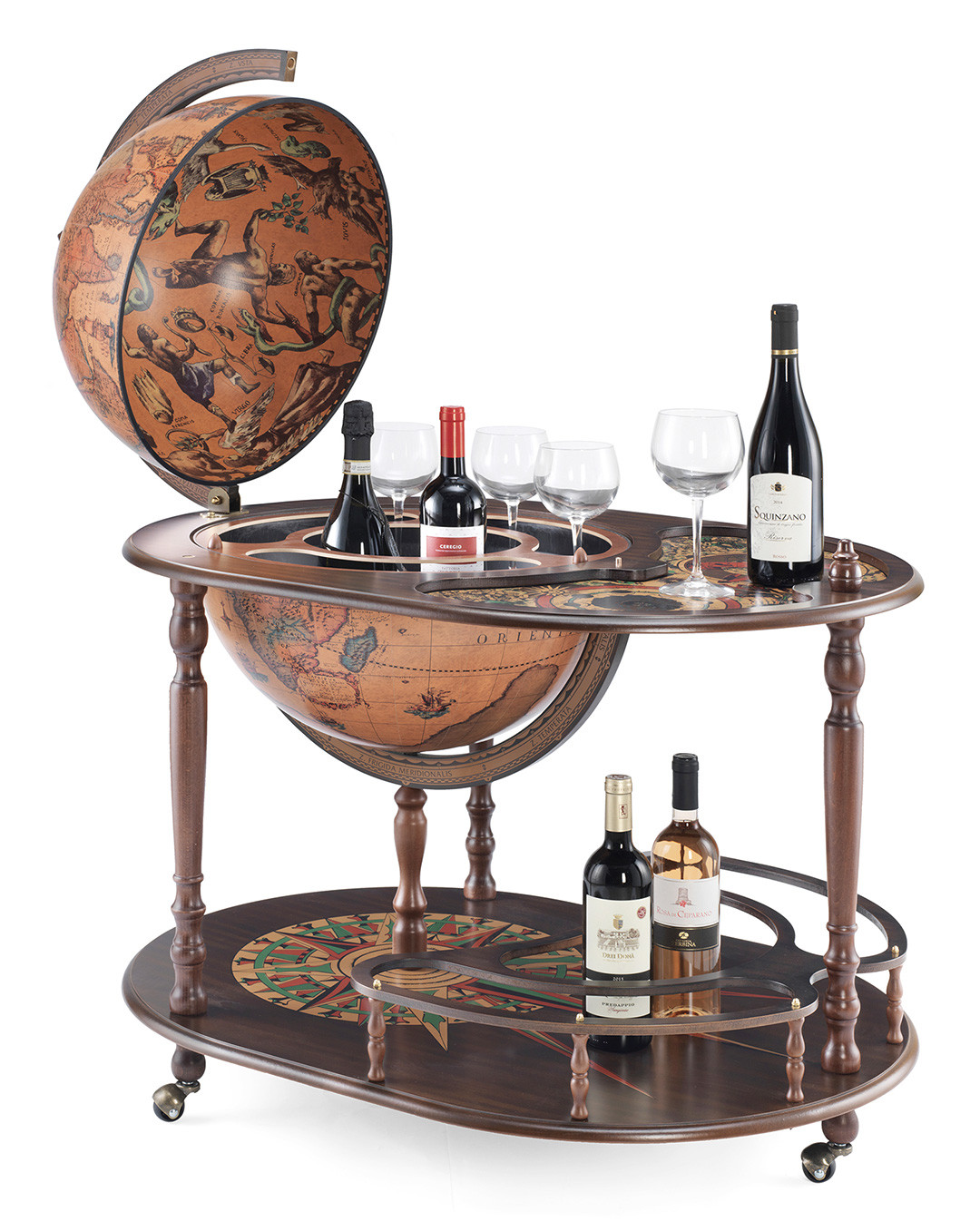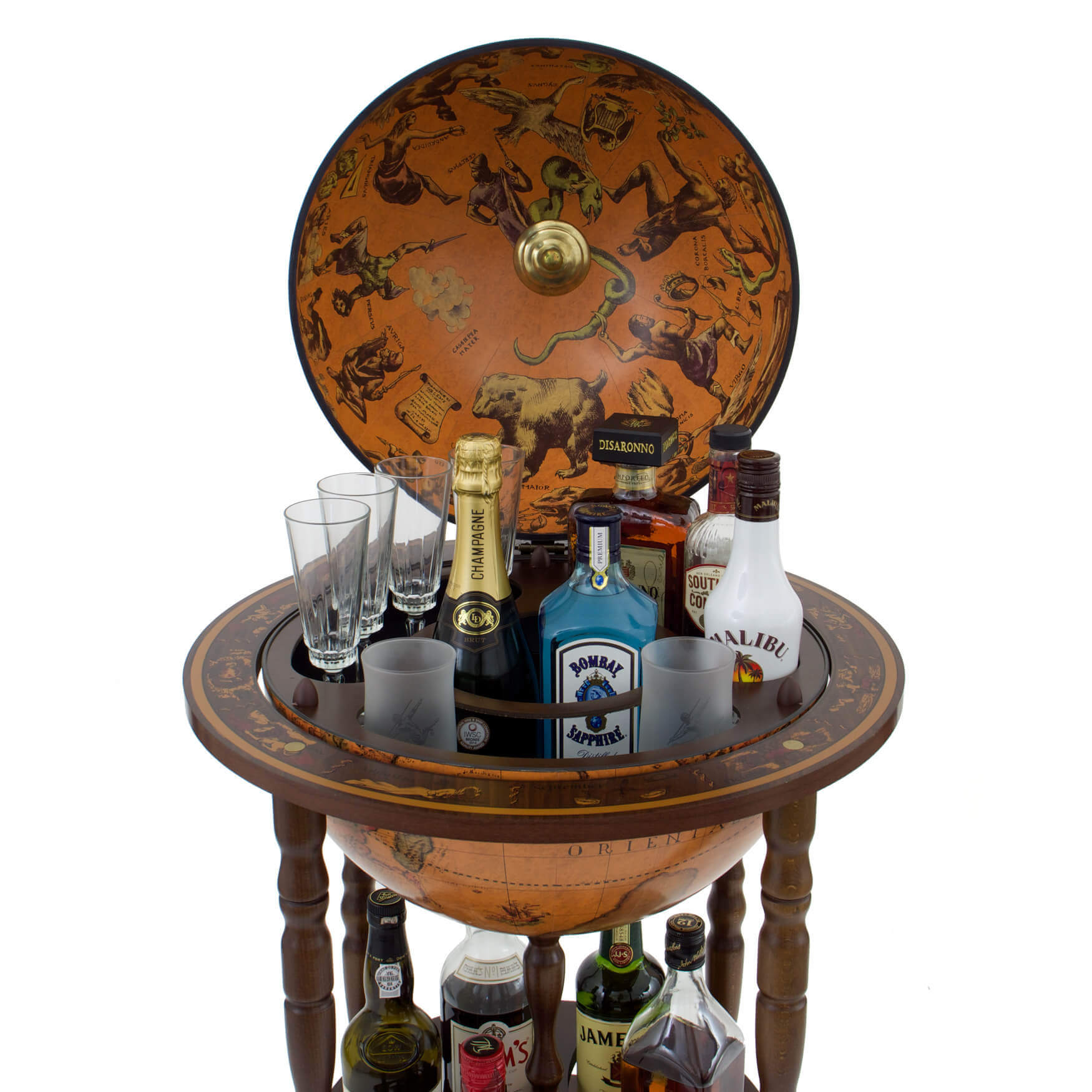Design and Functionality of Antique Bar Globe Drinks Cabinets

Antique bar globe drinks cabinets represent a unique blend of form and function, seamlessly merging the aesthetic appeal of a vintage globe with the practical utility of a bar cabinet. These captivating pieces are more than just storage; they are conversation starters, adding a touch of old-world charm and sophisticated elegance to any space. Their intricate designs and clever functionality make them highly sought-after collectibles and functional additions to homes and bars.
Antique bar globe drinks cabinet – These cabinets typically feature a meticulously crafted globe, often depicting geographical maps of the world, acting as the centerpiece and concealing the bar within. The globe itself can be made of various materials, ranging from intricately detailed hand-painted porcelain to more robust materials like wood or metal. The cabinet’s design complements the globe, often incorporating rich wood veneers, brass accents, and other decorative elements reflecting the style of the era in which it was produced.
Globe Styles and Cabinet Shapes
The styles of antique bar globe cabinets are as diverse as the periods they represent. Some feature classic, meticulously detailed globes, while others opt for a more stylized or simplified approach. Cabinet shapes vary, ranging from spherical designs that closely hug the globe to more rectangular or even custom shapes designed to fit specific spaces. Decorative features such as inlaid wood, carved details, and ornate brass hardware are common, enhancing the overall aesthetic appeal and reflecting the craftsmanship of the piece. For example, a late Victorian piece might boast highly polished mahogany and intricate brass hinges, while an Art Deco cabinet might showcase sleek lines and geometric patterns.
Storage Capacity and Accessibility
The functionality of these cabinets is as important as their aesthetic appeal. The internal storage capacity varies depending on the size and design of the cabinet. Smaller pieces might offer space for a limited selection of liquors, while larger ones can accommodate a more extensive collection. Accessibility is a key design feature; well-designed cabinets typically incorporate features such as easily accessible shelves, drawers for glassware, and sometimes even integrated ice buckets. The placement of shelves and compartments is carefully considered to optimize storage and ease of access to different items.
Comparison of Bar Globe Cabinet Styles
Different styles of bar globe cabinets offer unique characteristics. For instance, a Victorian-era cabinet might be characterized by its dark, rich wood tones, ornate carvings, and a focus on intricate detailing. In contrast, an Art Deco cabinet might display a more streamlined design with geometric patterns, polished surfaces, and a preference for simpler lines. Mid-century modern examples might incorporate lighter woods and a more minimalist approach to decoration. Each style reflects the design sensibilities of its era, resulting in a wide variety of aesthetics to choose from.
Example: A Hypothetical Antique Bar Globe Drinks Cabinet
Imagine a stunning antique bar globe drinks cabinet, circa 1920s.
- Dimensions: 36 inches (H) x 24 inches (W) x 24 inches (D)
- Materials: Polished mahogany wood with inlaid brass accents and a hand-painted porcelain globe.
- Globe Style: A vintage-style world map, accurately depicting continents and oceans in rich, detailed colors.
- Cabinet Features: Two hinged doors revealing adjustable shelves, a built-in ice bucket with a brass-lined ice scoop, and a small drawer for glassware or bar tools. Intricate brass hinges and a locking mechanism are included.
- Decorative Elements: Inlaid mahogany patterns around the globe’s base, ornate brass handles and feet, and a subtle Art Deco-inspired geometric design on the cabinet’s sides.
Collecting and Restoring Antique Bar Globe Drinks Cabinets

Owning an antique bar globe drinks cabinet is a testament to discerning taste and a passion for unique, functional art. These captivating pieces blend historical charm with practical utility, making them highly sought-after collectibles. However, successfully navigating the world of collecting and restoring these cabinets requires knowledge, patience, and a keen eye for detail.
Authenticity Verification of Antique Bar Globe Drinks Cabinets
Distinguishing genuine antique bar globe drinks cabinets from skillfully crafted reproductions is crucial. Authenticity hinges on several key factors. Examine the construction techniques: hand-crafted joinery, the type of wood used (consider the age and origin), and the quality of the globe itself are all important indicators. Look for signs of age, such as wear and tear consistent with its supposed age, minor imperfections, and variations in finish that are typical of handmade items. Reproductions often exhibit a uniformity and precision that’s uncommon in antique pieces. Furthermore, research the maker’s marks, if present, and compare them to known historical records. The presence of original hardware, such as hinges and latches, further strengthens authenticity claims. Consulting with experienced antique dealers or appraisers can provide invaluable expert opinions.
Restoring Damaged Antique Bar Globe Drinks Cabinets: A Step-by-Step Guide
Restoring a damaged antique bar globe drinks cabinet is a rewarding but challenging process. A methodical approach is essential. First, thoroughly document the cabinet’s current condition with photographs and detailed notes. This record serves as a roadmap throughout the restoration.
Cleaning is the initial step. Gently remove loose dirt and debris using a soft brush and vacuum. For stubborn stains, use appropriate wood cleaning solutions, always testing in an inconspicuous area first.
Repairing structural damage requires careful consideration. Cracks can be repaired using wood glue and dowels, ensuring proper alignment and clamping for secure bonding. Missing or damaged wood components might necessitate crafting replacements using similar wood types and techniques.
Refinishing involves stripping the old finish, carefully repairing any surface imperfections, and applying a new finish that complements the cabinet’s age and style. Techniques include sanding, staining, and applying varnish or lacquer in thin coats, allowing ample drying time between each coat.
Factors Influencing the Value of Antique Bar Globe Drinks Cabinets
Several factors influence the value of antique bar globe drinks cabinets. Age is a significant determinant; older cabinets, particularly those from the late 19th and early 20th centuries, command higher prices. Condition plays a crucial role; well-preserved cabinets with minimal damage fetch a premium compared to those requiring extensive restoration. Rarity, particularly those from specific makers or with unique features, significantly impacts value. The cabinet’s overall aesthetic appeal, including the quality of craftsmanship, materials, and artistic design, also contributes to its worth. Market demand and trends also play a part, with popular styles and designs commanding higher prices.
Hypothetical Restoration Project: Challenges and Solutions
Consider a 1920s bar globe cabinet with significant water damage, resulting in warping and swelling of the wood. The globe itself is cracked, and the original varnish is severely chipped and faded.
Challenge 1: Addressing the water damage. This requires careful drying to prevent further damage, followed by the application of wood consolidant to strengthen weakened wood fibers.
Solution: Gradual drying in a controlled environment, followed by the application of a professional-grade wood consolidant.
Challenge 2: Repairing the cracked globe. This delicate task requires specialized techniques to avoid further damage. It may involve using epoxy resin to stabilize the cracks and carefully filling any gaps with a compatible material.
Solution: Utilizing a high-quality epoxy resin designed for repairing delicate objects. Precise application and careful curing are essential.
Challenge 3: Refinishing the cabinet. Matching the original varnish is crucial to preserve the cabinet’s historical integrity. This may require extensive research to identify the original finish type and color.
Solution: Employing a skilled artisan specializing in antique furniture restoration. Careful color matching and meticulous application of the finish are paramount.
